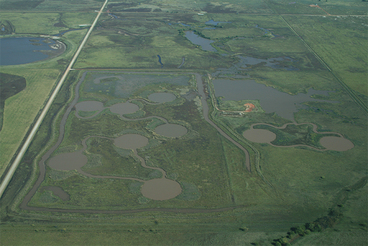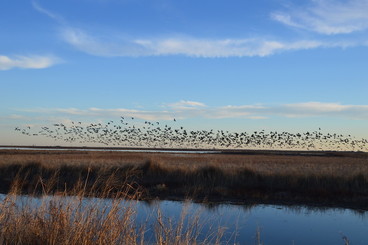Migratory Birds & Wetlands
Many bird species migrate south in the winter, not to avoid the cold temperatures, but because the availability of food and habitat decreases in the winter. More than 350 species of birds in North America head south each year where food resources and suitable habitat are plentiful.
Migration Flyways
Migratory birds are known to travel similar routes each year. Through banding and recovery research, these paths became known as significant flyways. In 1947, the U.S. Fish and Wildlife Service recognized four flyways in North America to guide migratory bird conservation and management: the Atlantic, Central, Mississippi, and Pacific flyways.
 The majority of Oklahoma falls within the Central Flyway, with a small eastern portion in the Mississippi Flyway.
Map Credit: National Wildlife Refuge Association
Migration Habitat
Migrating birds often travel thousands of miles and require suitable habitat along the way to rest, refuel, and find protection from inclement weather. Birds may use these stopover sites for a few hours, a few days, or even a few weeks.
Wetlands and their surrounding uplands and agricultural fields provide critical stopover habitat for many species, including waterfowl (ducks and geese), cranes, shorebirds, and waterbirds (herons, egrets, pelicans, gulls, terns, and cormorants). Wetlands and surrounding areas contain valuable food sources including plant seeds from smartweeds, sedges, and grasses for carbohydrates (energy) and invertebrates for protein. Wetland vegetation also provides important cover from predators. Suitable habitat is generally defined by broad groups of birds, such as dabbling ducks, diving ducks, shorebirds, etc. For example, ideal shorebird stopover sites are shallow water areas with sparsely vegetated mudflats and abundant invertebrate food resources. Whereas diving duck species prefer stopover areas with deeper water for foraging on submersed plants.
In Oklahoma, wetland stopover sites can be influenced by drought, as well as human disturbance. Because wetland condition can be highly variable in this region, a complex of wetlands (i.e., many smaller, relatively close wetlands) is often preferred over one large wetland. A high number of wetlands, as well as a diversity of wetland types improves the likelihood of meeting the needs for all migratory species.
 Drummond Flats Wildlife Management Area in north central Oklahoma covers approximately 4,600 acres. The area is predominantly a large wetland complex with surrounding upland habitat. By varying water levels across different wetland units, the area can support a greater diversity of migratory birds.
Photo Credit: Oklahoma Dept. of Wildlife Conservation
Waterfowl Hunting & Recreation
With large numbers of waterfowl migrating through and overwintering in Oklahoma, wetlands provide an ideal place for hunting and wildlife viewing. Waterfowl hunting regulations are species-specific, and seasons typically occur between October and February. Commonly hunted waterfowl species include mallards, wood ducks, scaup, redheads, canvasbacks, pintails, mergansers, and coots, as well as several species of geese.
To learn more about hunting seasons and licensing information, visit Oklahoma Dept of Wildlife Conservation - Waterfowl.
Public Areas for Bird Watching
Waterfowl and shorebirds can be seen in significant numbers across the state during fall migration. To experience the awe of these large populations first-hand, and learn about the importance of wetlands for migration, try heading out to some of the popular bird watching areas across Oklahoma, including wildlife refuges, wildlife management areas, and state parks.
 Sequoyah National Wildlife Refuge in eastern Oklahoma covers over 20,000 acres and includes expansive bottomland hardwood forests and wetlands. These areas provide stopover sites for large flocks of migrating waterfowl, including thousands of mallards, gadwall, pintail, teal, wigeon, shoveler, and wood ducks. Also, in November and December, flocks of snow geese can reach 20,000 individuals.
Photo Credit: U.S. Fish and Wildlife Service
 Hackberry Flat Wildlife Management Area in western Oklahoma covers 7,120 acres, including a large complex of wetland units. There are currently 8 water control structures, almost 10,000 ft of dikes, and 5 wetland units. The area supports large numbers of waterfowl, shorebirds, and wading birds during migration.
Photo Credit: Oklahoma Dept. of Wildlife Conservation
 Salt Plains National Wildlife Refuge in Alfalfa County, Oklahoma covers over 32,000 acres and has been established as a migratory bird sanctuary. The expansive salt flats are a major migration rest area for hundreds of thousands of migratory waterfowl and shorebirds. Peak numbers of ducks, geese, and cranes can approach 400,000. The endangered whooping crane can also be seen during migration.
Photo Credit: U.S. Fish and Wildlife Service |